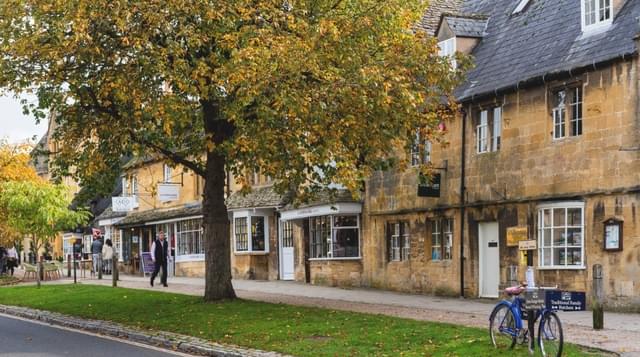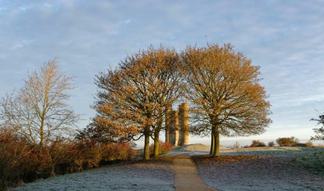Richard Blakemore from iNews visited the beautiful village of Broadway in Worcestershire.
The ancient settlement of Broadway, on the eastern edge of the Vale of Evesham in south-east Worcestershire, was thriving when the Domesday Book was written and grew rich from the wool and cloth trade over the centuries. The steep slopes of the Cotswold escarpment provided grazing for sheep and an inexhaustible supply of honey-coloured limestone, with which wealthy medieval merchants built fine houses along the main road (“the broad way”) and in so doing created one of the longest village high streets in England.
By the 1600s, Broadway was a busy stagecoach stop on the route from Worcester to London. But as coach travel declined, the village mellowed into a sleepy backwater.
When William Morris – the leading influence in the Arts and Crafts movement – adopted the hilltop Broadway Tower as his country retreat in 1880, many of the village’s handsome buildings were run-down, making it an ideal affordable base for artists. Among the Victorian creatives who “colonised” Broadway were the American painters John Singer Sargent, Frank Millet and Edwin Austin Abbey.
Broadway has since evolved into a quintessential Cotswold “show village” of delightful historic architecture.

How to get there and around
The closest railway stations are Honeybourne (5.7 miles) and Evesham (8.7 miles), both served by Great Western. Cross Country connections are possible at Worcestershire Parkway. Buses from Evesham to Broadway run five times a day on weekdays. A taxi from Evesham station to Broadway will cost around £17, but expect to pay more if returning to Evesham on a Sunday.
Walking the length of Broadway’s main street and side alleys is easy and relatively flat, but you will need transport to visit outlying villages and attractions.

Drop your bags
The Lygon (pronounced “Liggon”) Arms – a predominantly Tudor coaching inn first recorded in 1377 as The White Hart – dominates the village centre but remains cosy and welcoming. It had a multimillion-pound makeover in 2017 and now has 86 rooms, three acres of gardens, a spa with pool, and two dining areas: the Lygon Bar & Grill, housed in a grand former ballroom with barrel-vaulted ceiling and antler chandeliers, and the more relaxed Lygon Wine Bar. Winter doubles from £195 B&B.

Browse the shops
Catesbys, a smart little emporium, sells modern and contemporary British paintings, prints, sculpture and ceramics, plus elegant tableware, furnishings and rare decorative objects. Current bestsellers include festive lights and food-shaped Christmas baubles.
The Man Cave is three floors of quirky gifts, from auto memorabilia, clothing and accessories to retro arcade machines, rare BMX bikes and prestige car parts transformed into artwork.
Just off the High Street in Cotswold Court shopping centre is John Barleycorn’s, a specialist off-licence-cum-deli with a vast array of award-winning beers, ciders and foods from local breweries and farmers.
And the Broadway Deli is stuffed with colourful produce, its window displays like something from an Advent calendar.
Cosy cafés
The Leaf & Bean Tea and Coffee Lounge, opposite the village green, lists fresh soups and scones, with hot food and well-packed sandwiches.
For more of a Downton Abbey-style experience, try Tisanes – a traditional English tearoom where staff in vintage pinafores serve breakfasts, lunches and light meals, home-made cakes and snacks and more than 40 varieties of leaf tea. The café also sells preserves, chutneys, gift hampers and tea-related memorabilia.
Rainy day refuges
Renowned 20th-century designer Sir Gordon Russell used to have his drawing office and workshop behind The Lygon Arms. This now houses the Gordon Russell Design Museum, which celebrates his life and the work of his furniture company, from Arts and Crafts cabinet-making to 30s Modernism, the 1951 Festival of Britain and beyond.
Broadway Museum and Art Gallery, located in a former inn, is one of the few 17th-century village buildings open to the public and charts Broadway’s evolution. Alongside medieval furniture sit displays about the wool industry, the stagecoach trade, the artists’ colony and a “cabinet of curiosities” like those collected by wealthy Victorian travellers. A “Journey Through Steam” exhibition, recalling the history of the Great Western Railway, runs until 7 May (Sat-Thurs, £5).

A drink by the fire
In its stagecoach heyday, Broadway could count 35 inns and beer sellers compared with the five that survive today. Just behind the village green sits the Crown & Trumpet, a 17th-century hostelry recommended in the Campaign for Real Ale’s Good Pub Guide for 35 years. It has seasonal beers, an open fire, home-cooked meals and hearty Sunday roasts (pre-booking essential). There are also five bedrooms upstairs.
Dinner time
The award-winning Russell’s of Broadway, a “restaurant with rooms” housed in Sir Gordon’s former furniture showroom, has a modern, airy dining area and head chef Jorge Santos conjures up contemporary British cuisine. Dishes might include wild sea bass with braised lentils, samphire and mussels (£29), trio of pork with caramelised onion purée and leek mash (£30) and a mouth-watering 28-day aged fillet of Scotch beef with king oyster mushroom, Parma ham wrapped beans and beef-fat chips (£35).
A recent mid-range addition to Broadway’s foodie scene is the Flipside diner, offering proper “roll up your sleeves” burgers (prime Hereford beef, chicken or veggie) in award-winning brioche buns, alongside three types of fries, sauces and traditional Sicilian gelati.
Winter walks
A popular walk for weekend visitors is the four-mile circular trek up to Broadway Tower, a faux-medieval folly completed in 1798 for the 6th Earl of Coventry. This moderately difficult hike is steep in places and takes two to three hours (longer if you factor in visits to the tower, the estate’s 50-acre deer park and café). But the views from the top, across 16 counties and 62 miles in each direction, are spectacular on a clear day and well worth the effort.
For serious ramblers, the Cotswold Way and Wychavon Way both pass through Broadway. The latter follows a 40-mile linear route to the spa town of Droitwich and can be completed in about four days.
Three things you might not know about Broadway…
1) Broadway’s High Street is believed to be unusually wide because of the two small streams that used to run each side of it; homes were built on either side of the brooks and the road formed down the middle.
2) Broadway features in the 2018 video game Forza Horizon 4. Players can race hot rods and custom cars around the village before using a ramp to jump over St Michael and All Angels Church.
3) The US artist John Singer Sargent began his famous Impressionist painting Carnation, Lily, Lily, Rose in the garden of Farnham House in 1885, completing it the following year at Russell House. The original hangs in the Tate Gallery in London.






